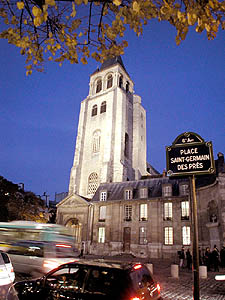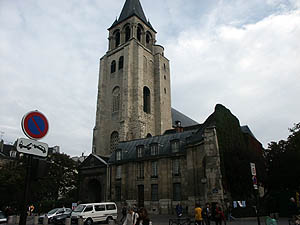Latin Quarter - Saint-Germain des Pres

65 meters long, 21 meters wide and 19 meters high St Germain is a small church. Given the various destructions and multiple restorations, this building's Roman architecture has much changed since the 11th century, though many of its original elements remain intact.
The tops of the altar (in four bays) present traditional themes characteristic of Roman style : in particular, figures of monsters and birds?. Built between 990 and 1014, the original massive front tower or "Clocher-Porche", part of three original bell towers and still in existence, is one of the oldest in France. The tower's archways and spires which were restaured during the last century, date back to the 12th century as does the principle facade. The original stacks of the two primitive, lateral towers are also still visible. The architecture of the archway (walkway) dating from the 12th century reamins more or less intact. It is surrounded by five chapels of ribbed vaults dedicated in 1163 by Pope Alexander the 3rd. Only the windows of the fourth chapel conserve fragments of stained glass from the 11th century.

The arcades, constructed around 1163 are based on a model by Senlis, Saint-Denis and Noyon. They used to support the lofts (as in the Church of Notre Dame), which were eventually removed in 1646. The marble shafts are much older and come from the primitive edifice designed by Childebert. These constitute the most beautiful Merovingian remnants in Paris. The altar's admireable colums of triforium date back to the first Merovingian basilica built in the 7th century. Its decorations are recent and stand out by their academism. The wall paintings are works by a student of Ingres, Hippolyte Flandrin. Many of his works can be found in the Louvre. These wall paintings, done in 1846, represent the "Entrance of Christ into Jerusalem", (on the north side) and the Carrying of the Cross, on the south side.